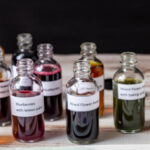Natural Watercolor Paints Made from Plants
Learn how to make your own watercolor paints from nature using plants from your backyard and a few other ingredients from the kitchen.
Equipment
- small pot used for crafting not food
- small funnel that fits your bottles
Materials
- flowers, leaves, berries...
- watercolor paper cut into strips
- alum
- coffee filters or cheesecloth
- mason jar or other clean jar
- rubber band
- baking soda
- fresh lemon juice
- gum arabic
- pipette or dropper
- small glass bottles
- whole cloves
Instructions
- Gather plant materials. Rinse well and dry.
- Place about 1 cup of plant material in a pot. Stick to leaves or petals not stems.
- Cover with 2 cups of water.
- Add 1/2 teaspoon of alum and stir.
- Bring to a boil then turn the heat to low and simmer for 20 minutes.
- Cut a piece of watercolor paper and dip it into the water to see the color.
- Continue to simmer the plants for a longer period and test again if desired.
- Remove from heat and allow the mixture to cool.
- Strain the ink from the plant material by attaching a coffee filter or cheesecloth to the top of a jar with a rubber band.
- Pour some of the watercolor paint into small bowls.
- Add some baking soda about 1/2 teaspoon to one bowl and 1/2 teaspoon or more of lemon juice to the other and see how the color changes.
- Add one whole clove to the bottle you will keep the paint in as a preservatie.
- Use a funnel to pour the results into the bottles.
- Add several drops of gum arabic as a binder to thicken the ink.
- Place a cap on each bottle and label them with paper and tape.
Notes
Avoid plants that are toxic or any that you or your family are allergic to. Make sure you are working in a well-ventilated room or outside.
Some people use white vinegar and salt instead of alum.
You can use copy paper for testing. The watercolor paper works better.
I've also read that you could use honey to thicken the paint instead of gum arabic.
Tried this project?Tag @hearthnvine on Instagram
